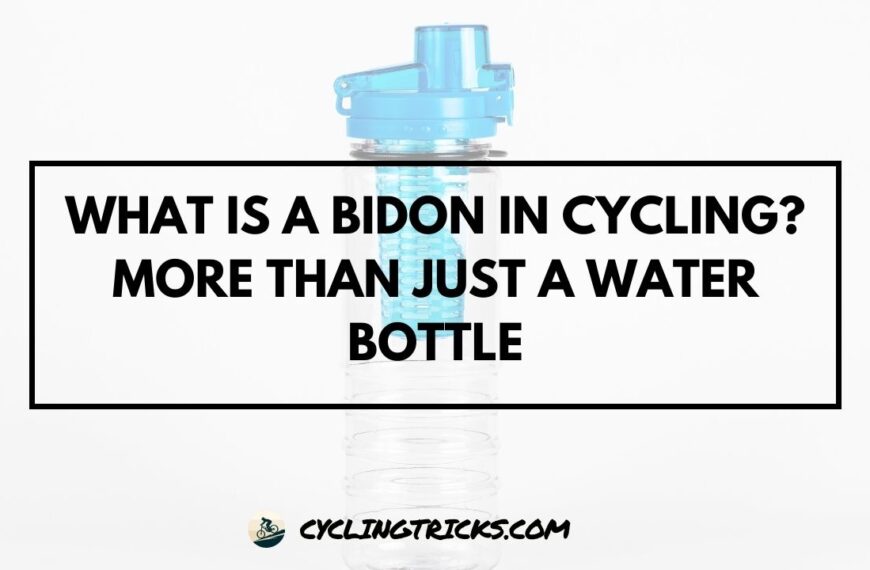Did you know that a dirty and poorly lubricated bike chain can decrease your bike’s efficiency by up to 20%?
It’s true! Neglecting proper maintenance of your bike chain can lead to increased friction, wear, and unnecessary strain on your bike’s drivetrain.
By following best practices for bike chain maintenance, you can ensure that your bike chain is clean and well-lubricated, allowing for a smoother and more enjoyable ride.
In this article, I will provide practical tips and step-by-step instructions on how to effectively clean and lubricate your bike chain, as well as the importance of regular maintenance. So let’s get started and keep your bike chain in top shape!
Key Takeaways:
- Regular bike chain maintenance is crucial for a smooth and efficient ride.
- A dirty and poorly lubricated bike chain can decrease your bike’s efficiency by up to 20%.
- Proper cleaning and lubrication of your bike chain can extend its lifespan and optimize your overall biking experience.
- By following best practices for bike chain maintenance, you can prevent unnecessary wear and strain on your bike’s drivetrain.
- Stay tuned for detailed instructions and tips on how to clean, lubricate, and maintain your bike chain effectively.
Importance of Bike Chain Maintenance
Proper bike chain maintenance is of utmost importance for the longevity and performance of your bike. Neglecting to clean and lubricate your bike chain regularly can lead to increased wear and tear, decreased efficiency, and potential damage to other bike components.
Regular cleaning and lubrication are essential to remove dirt, grime, and debris that accumulate on the chain during rides. When left uncleaned, these particles can cause increased friction, leading to chain wear, noise, and poor shifting performance. By maintaining a clean chain, you ensure smooth and efficient pedal strokes, allowing you to enjoy a more comfortable and effortless ride.
In addition to cleanliness, proper lubrication is crucial for reducing friction between the chain links. Applying a high-quality bike chain lubricant not only minimizes the wear between the chain and the cassette, but it also prevents rust and corrosion, extending the life of your chain.
The Benefits of Effective Bike Chain Maintenance
Regular bike chain maintenance offers several benefits, including:
- Extended Chain Life: By cleaning and lubricating your chain regularly, you reduce the risk of chain elongation and premature wear. This extends the lifespan of your chain, reducing the need for frequent replacements.
- Improved Shifting Performance: A clean and well-lubricated chain ensures smooth gear shifting, allowing you to effortlessly transition between gears without any hiccups or delays.
- Enhanced Pedaling Efficiency: A properly maintained chain reduces friction, resulting in better power transfer from your legs to the wheels. This improves your pedaling efficiency, allowing you to ride faster and with less effort.
- Noise Reduction: A clean and lubricated chain operates quietly, minimizing irritating chain noise and providing a more pleasant riding experience.
Make Bike Chain Maintenance a Routine
To enjoy these benefits, it’s essential to make bike chain maintenance a regular part of your bike care routine. Set aside time to clean and lubricate your chain after every few rides or if it becomes visibly dirty. Additionally, check your chain for signs of wear and perform any necessary adjustments.
Remember, effective bike chain maintenance not only enhances your overall biking experience but also contributes to the longevity and performance of your bike.
By giving your chain the attention it deserves, you’ll ensure that it operates smoothly and reliably, allowing you to enjoy countless miles on the road or trail.
| Benefits of Effective Bike Chain Maintenance |
|---|
| Extended Chain Life |
| Improved Shifting Performance |
| Enhanced Pedaling Efficiency |
| Noise Reduction |
Tools and Supplies Needed
To effectively clean and lubricate your bike chain, you will need a few essential tools and supplies. Whether you prefer a DIY approach or choose to use specialized products, having the right equipment will ensure that you can properly care for your bike chain. Here is a list of items you will need:
- Bike chain cleaning solution: A specially formulated cleaning solution designed to remove dirt, grime, and grease from your bike chain.
- Bristle brush: A small brush with stiff bristles that helps to scrub away stubborn dirt and debris from the chain.
- Chain cleaning device: An innovative tool that provides a convenient and efficient way to clean your bike chain. It typically consists of rotating brushes that agitate the chain, removing dirt and grime.
- Cleaning rag or sponge: Use a clean rag or sponge to wipe away excess cleaning solution and stubborn dirt from the chain.
- Lubricant: A high-quality bike chain lubricant that is specifically designed to reduce friction and protect the chain from wear and tear. Choose a lubricant suitable for your riding conditions.
- Rag or towel: A clean cloth or towel to apply the lubricant to the chain and remove any excess.
- Chain wear indicator tool: This tool helps you determine if your chain has stretched or worn, indicating when it needs to be replaced.
These tools and supplies will ensure that you have everything you need to effectively clean and lubricate your bike chain, keeping it in optimal condition. Whether you are a seasoned cyclist or a beginner, proper bike chain care is essential for a smooth and enjoyable ride.
Preparing Your Bike for Chain Maintenance
Before you dive into the bike chain cleaning process, it’s important to prepare your bike properly. Taking a few simple steps will ensure that you can give your bike chain the attention it needs for optimal maintenance. Follow these steps to get started:
- Secure your bike: Find a stable surface to work on, such as a bike repair stand or a stable table. This will make it easier to access the bike chain and prevent any accidental movement while cleaning.
- Shift your bike to the smallest chainring and rear cog: This will create slack in the bike chain, making it easier to remove and clean. Ensure that your bike is in a gear combination that allows the chain to hang freely.
- Inspect the chain for any visible damage: Take a moment to visually inspect the bike chain for any signs of wear or damage, such as bent or missing links. If you notice any issues, it’s a good idea to address them before proceeding with the cleaning process.
- Remove dirt and debris: Use a soft brush or a clean cloth to gently remove any loose dirt or debris from the bike chain. This will prevent these particles from grinding into the chain during the cleaning process.
- Check the drivetrain: Take a quick look at the drivetrain components, including the cassette, rear derailleur, and chainrings. If you notice any buildup of dirt or grease, it’s recommended to clean these components as well or consider a more thorough bike cleaning.
By preparing your bike properly, you’ll create an ideal environment for effective bike chain maintenance. This step is essential to ensure that you can focus on cleaning the chain thoroughly without any distractions.
Cleaning the Bike Chain
When it comes to bike chain maintenance, cleaning is a crucial step that should not be overlooked. A clean chain not only improves performance but also prolongs the lifespan of your bike’s drive system.
In this section, I will walk you through different cleaning methods and provide step-by-step instructions on how to clean your bike chain effectively. Whether you prefer using a degreaser or a homemade cleaning solution, I will cover the best practices to ensure a thorough clean.
Method 1: Degreaser and Brush
One of the most common methods for cleaning a bike chain is using a degreaser and a brush. Here’s a step-by-step guide:
- Begin by shifting the chain onto the smallest chainring and smallest rear cog, so it is easier to access and clean.
- Apply a suitable degreaser to the chain, focusing on the dirtiest areas. You can use a spray degreaser or apply it directly from a bottle.
- Use a stiff-bristled brush, such as a chain brush or an old toothbrush, to scrub the chain thoroughly. Make sure to clean all sides of the chain.
- Rotate the pedals backward while continuing to brush the chain. This helps to remove dirt and grime embedded between the links.
- Once you have thoroughly cleaned the chain, rinse it with water to remove any remaining degreaser.
- Dry the chain using a clean cloth and make sure it is completely dry before proceeding to the next step.
Method 2: Homemade Cleaning Solution
If you prefer a more eco-friendly approach or don’t have a degreaser on hand, you can create a homemade cleaning solution. Here’s how:
- Mix equal parts of water and biodegradable dish soap in a container. You can also add a small amount of baking soda for extra cleaning power.
- Dip a brush or a rag into the cleaning solution and apply it to the chain.
- Scrub the chain thoroughly, ensuring all sides are cleaned.
- Similar to Method 1, rotate the pedals backward while brushing to remove ingrained dirt.
- Rinse the chain with water to remove the cleaning solution.
- Dry the chain completely using a clean cloth.
Remember, regardless of the cleaning method you choose, it is essential to thoroughly dry the chain before lubricating.
By following these cleaning methods and best practices for bike chain cleaning, you can ensure that your bike chain remains in top condition. Now that your bike chain is clean, it’s time to move on to the next step: lubrication.
Removing Stubborn Grease and Grime
When it comes to bike chain maintenance, sometimes you encounter stubborn grease and grime that require a little extra effort to remove. In this section, I’ll share some effective tips and techniques to tackle these tough substances, ensuring your bike chain sparkles in no time.
Using Brushes
One of the best tools for removing stubborn grease and grime is a sturdy brush. Look for a brush with tough bristles that can easily penetrate the chain links and scrub away the buildup.
Pro Tip: A stiff-bristle brush like the Park Tool GSC-1 works wonders for cutting through tough grime. Simply dip the brush in a cleaning solution and gently scrub the chain, paying extra attention to the areas with heavy buildup.
As you scrub, make sure to rotate the pedals backward to allow the brush bristles to reach every part of the chain. Don’t forget to clean the derailleur pulleys and chainrings as well.
Using Rags
Another effective method for removing stubborn grease and grime is using clean rags or shop towels. Apply a degreaser or a cleaning solution to the rag and then wrap it around the chain. Hold the chain firmly with one hand and rotate the pedals backward, allowing the rag to wipe away the buildup.
Pro Tip: Choose a lint-free rag or microfiber cloth to avoid leaving any residue behind. The Park Tool CM-5.3 Cyclone Chain Scrubber is a handy tool that combines both the brush and rag techniques, making the cleaning process even more efficient.
Other Tools and Techniques
In addition to brushes and rags, there are other tools and techniques to consider:
- Chain cleaning devices like the Finish Line Pro Chain Cleaner provide a quick and thorough clean by agitating the chain with solvent or degreaser.
- A toothbrush or small sponge can be useful for reaching tight spots and removing stubborn grime.
- For extremely tough buildup, using a small amount of penetrating oil or WD-40 followed by cleaning can help break down the grease and make it easier to remove. However, make sure to thoroughly clean and degrease the chain afterward.
Remember, stubborn grease and grime require a bit of patience and effort, but with the right tools and techniques, you can restore your bike chain to its pristine condition.
| Tools and Products | Benefits |
|---|---|
| Stiff-bristle brush | – Effectively cuts through tough grime – Reaches all parts of the chain |
| Lint-free rag or microfiber cloth | – Provides a residue-free clean – Easy to maneuver around the chain |
| Chain cleaning device | – Agitates the chain for a thorough clean – Saves time and effort |
| Toothbrush or small sponge | – Helps reach tight spots – Removes stubborn grime |
| Penetrating oil or WD-40 | – Breaks down tough grease buildup – Facilitates easier removal |
Drying the Bike Chain
After cleaning your bike chain, it is important to ensure that it is thoroughly dried before applying lubrication. Properly drying the chain is crucial to prevent rust and ensure the effectiveness of the lubrication.
In this section, I will explain different methods for drying your bike chain and offer recommendations on how to expedite the drying process.
Air Drying
One of the simplest and most effective ways to dry your bike chain is to let it air dry naturally. After cleaning, hang your bike upside down or prop it up in a well-ventilated area.
This allows air to circulate around the chain, facilitating the drying process. Depending on the weather conditions, air drying can take several hours or even overnight.
Towel Drying
If you want to speed up the drying process, you can use a clean, lint-free towel to dry the bike chain. Carefully run the towel along the length of the chain, applying gentle pressure to remove any excess moisture. Make sure to reach all the nooks and crannies, including between the chain links. This method helps to remove the majority of the moisture, but some residual dampness may remain.
Pro Tip: If you choose to towel dry your bike chain, be sure to use a towel that you don’t mind getting dirty. Cleaning bike chains can be a messy process, and residual grime might transfer onto the towel during drying.
Hairdryer Method
If you want to dry your bike chain more quickly, you can use a hairdryer. Set the hairdryer to a low heat setting and hold it a few inches away from the chain.
Move the dryer along the length of the chain, ensuring that every section gets equal exposure to the warm air. Be cautious not to use excessive heat, as it can damage the chain or other components of your bike.
Compressed Air
Another option for drying your bike chain is to use compressed air. You can use a compressed air gun or an air compressor with a nozzle attachment. Hold the nozzle close to the chain and direct the air to remove any moisture.
This method works well for removing water from hard-to-reach areas, such as between the chain links or inside the derailleur pulleys. However, it is essential to use caution and not apply too much pressure, as it can force water deeper into the components.
Pro Tip: When using compressed air, always wear appropriate eye protection to prevent any debris from getting into your eyes.
By choosing one of these methods, you can ensure that your bike chain is thoroughly dried before applying lubrication. This step is crucial to maintain the performance and longevity of your bike chain, preventing rust and preserving its smooth operation.
Choosing the Right Bike Chain Lubricant
When it comes to bike chain lubrication, selecting the right lubricant is key to ensuring optimal performance. Different types of lubricants are available, each with its own specific applications and benefits. Here, I’ll guide you through the considerations for choosing the perfect lubricant for your riding conditions and preferences.
Types of Lubricants:
- Wet Lubricants: Designed for wet and muddy conditions, wet lubricants offer excellent durability. They are water-resistant and provide long-lasting protection against rust and corrosion. Wet lubricants are ideal for off-road riders and those who frequently encounter wet weather conditions.
- Dry Lubricants: Suitable for dry and dusty conditions, dry lubricants leave a dry, wax-like coating on the chain. This coating reduces dirt and dust accumulation, preventing wear. Dry lubricants are popular among road cyclists and riders in dry climates.
- Ceramic Lubricants: Offering ultra-low friction and superior performance, ceramic lubricants are designed to reduce drivetrain friction and increase efficiency. They are highly durable and ideal for riders seeking maximum performance.
Choosing the Right Lubricant:
When selecting a bike chain lubricant, consider the following factors:
- Riding Conditions: Determine the typical weather and terrain conditions you ride in. Consider whether you encounter wet, dry, or dusty conditions.
- Frequency of Application: Some lubricants require more frequent application than others. Evaluate how often you are willing to reapply the lubricant.
- Longevity: Look for lubricants that offer long-lasting protection and durability, especially if you engage in intense or prolonged riding.
- Cleanliness: Consider the level of cleanliness you prefer. Some lubricants attract less dirt and debris, while others may require more frequent cleaning.
Table:
| Lubricant Type | Riding Conditions | Application Frequency | Longevity | Cleanliness |
|---|---|---|---|---|
| Wet Lubricants | Wet and muddy | Less frequent | Long-lasting | Attracts more dirt |
| Dry Lubricants | Dry and dusty | More frequent | Moderate | Attracts less dirt |
| Ceramic Lubricants | All conditions | Moderate | Long-lasting | Varies by brand |
Applying Lubricant to the Bike Chain
Now that you have selected the perfect lubricant for your bike chain, it’s time to apply it with precision and care. Proper lubrication is essential to ensure optimal performance and longevity of your chain. Follow these best practices for bike chain lubrication:
- Clean the Chain: Before applying any lubricant, make sure your bike chain is clean and free from dirt, debris, and excess grease. Refer to Section 5 for detailed instructions on cleaning the bike chain.
- Positioning: Rotate your bike’s pedals while holding a clean cloth or rag against the lower section of the chain. This will help catch any excess lubricant and prevent it from dripping onto the ground.
- Apply the Lubricant: Squeeze a small amount of lubricant onto the inner side of the bike chain, directly above the bottom bracket or derailleur pulleys. Slowly rotate the pedals backwards while applying the lubricant, ensuring that each link of the chain is adequately coated.
- Avoid Over-Lubrication: Excess lubricant can attract dirt and debris, leading to a grime buildup on your chain. Be mindful not to apply too much lubricant, as it can negatively affect the performance of the chain.
- Let it Settle: After applying the lubricant, allow it to settle for a few minutes. This will give the lubricant a chance to penetrate the inner components of the chain and create a protective barrier.
- Remove Excess Lubricant: Using a clean cloth or rag, gently wipe off any excess lubricant from the outer side of the chain. This will help prevent dirt and grit from sticking to the chain, ensuring a smooth and efficient ride.
Pro tip: For easier application and better distribution of the lubricant, consider using a specialized chain lubrication tool, such as a chain lube applicator or a brush with built-in reservoir.
Remember, regular bike chain lubrication is crucial for optimal performance and longevity. Depending on your riding conditions, it is recommended to lubricate your bike chain every 100-200 miles or once a month.
| Lubricant Type | Pros | Cons |
|---|---|---|
| Dry lubricants | – Clean and long-lasting – Doesn’t attract dirt and grit | – Less suitable for wet conditions |
| Wet lubricants | – Provides excellent protection against moisture – Ideal for wet and muddy conditions | – Attracts dirt and requires more frequent cleaning |
| Ceramic lubricants | – Reduces friction and increases efficiency – Long-lasting performance | – Expensive |
Maintaining the Bike Chain
Proper bike chain maintenance is essential to ensure smooth and efficient rides. In addition to regular cleaning and lubrication, there are several other best practices you can follow to maximize the lifespan of your bike chain.
Here are some tips to help you maintain your bike chain:
Cleaning Frequency
To keep your bike chain in optimal condition, it’s important to clean it regularly. The frequency of cleaning depends on various factors, such as riding conditions, weather, and terrain. As a general guideline, it is recommended to clean your bike chain every 100-200 miles or whenever it appears dirty or noisy.
Inspection
Regularly inspecting your bike chain can help identify any issues before they become major problems. Check for signs of wear, such as elongation or rust, and ensure that the chain is properly aligned and tensioned. If you notice any abnormalities, it may be time to replace the chain or seek professional assistance.
Troubleshooting Common Issues
While regular maintenance can prevent many chain-related problems, occasional issues may still arise. Here are some common problems you may encounter and how to address them:
Chain Skipping: If your chain skips or slips, it may be due to a worn cassette or chainring. Consider replacing these components if necessary.
Squeaky Chain: A squeaky chain can be caused by insufficient lubrication. Apply a suitable bike chain lubricant to resolve the issue.
Excessive Chain Wear: Over time, the chain will naturally wear out. Regularly check for elongation using a chain wear indicator tool, and replace the chain if it exceeds the recommended limit.
Proper Lubrication
Applying the right lubricant is crucial for the smooth functioning of your bike chain. Remember to choose a lubricant specifically designed for bike chains, considering factors such as weather conditions and riding intensity. Apply the lubricant evenly along the chain, wiping off any excess with a clean rag. Avoid over-lubrication, as it can attract dirt and debris.
Protective Measures
To further protect your bike chain, consider using a chain guard or protective cover. These accessories help shield the chain from external elements, such as dirt, water, and debris, prolonging its lifespan and reducing the need for frequent cleaning and maintenance.
Tips for Bike Chain Maintenance:
- Regularly clean your bike chain to remove dirt and grime.
- Inspect your chain for signs of wear and misalignment.
- Troubleshoot common issues like skipping or squeaky chains.
- Choose the right lubricant for your riding conditions and apply it properly.
- Consider using a chain guard or protective cover.
Conclusion
In conclusion, maintaining your bike chain is essential for a smooth and enjoyable riding experience. By following the best practices for cleaning and lubricating your bike chain, you can enhance its performance and prolong its lifespan.
Regular maintenance will ensure that your bike chain remains in top condition, allowing you to make the most of your cycling adventures.
Remember to prepare your bike properly before cleaning and use the right tools and supplies for the task. Thoroughly clean the chain, removing any stubborn grease or grime buildup.
After cleaning, ensure that the chain is completely dried before applying the appropriate lubricant. Choose the right lubricant for your riding conditions and apply it evenly to the chain.
By incorporating these maintenance practices into your routine, you can optimize the performance of your bike chain and prevent unnecessary wear and tear. So, don’t forget to give your bike chain the care it deserves and enjoy many miles of smooth and efficient cycling!









